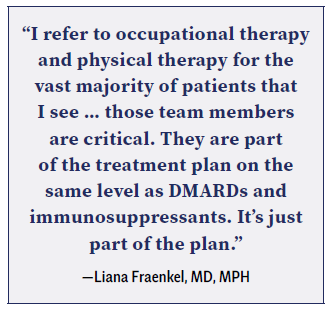The ARP: Nothing Stays the Same … Nor Should It
The ARP has continually evolved during its 60-year history, with one of the most notable changes being its integration into the ACR. For approximately 30 years, the ARP was a section within the Arthritis Foundation, until it joined the ACR in 1994.13 Since then, great strides have been made to more closely integrate the ARP into the ACR. Initially, the ARP maintained a full complement of ARP-specific committees and had individual representation on some ACR committees.
Although this arrangement helped meet ARP member needs and fostered leadership development, it did not facilitate integration within the ACR or interdisciplinary collaboration between physicians and the many disciplines represented within the ARP.
Over time, many ARP and ACR committees merged and included increased ARP representation. Currently, ACR committees typically include two to four ARP members. The ARP president is now a full voting member of the ACR Board of Directors and Executive Committee. This combined structure has strengthened connections between the organizations, fostering increased understanding among physicians and ARP members and better facilitating interdisciplinary collaboration.
The merging of committee structures has strengthened both organizations. The ARP has used its seat at the table to inform ACR members of its diverse membership, advocate for addressing patient needs from a broad perspective and highlight ARP members’ skills and tools to address those needs.
While the ACR/ARP organizational integration has been successful, it also presents challenges that must be monitored and mitigated. For example, ARP members have limited opportunities to develop their ARP leadership perspective and skills before being appointed to represent the organization on blended committees. It is essential the ARP ensure its committee members are well prepared to represent its broad membership. With fewer ARP committees, and, thus, fewer leadership opportunities for members, the ARP needs to intentionally focus on leadership development.
Another challenge presented by the organizational integration is meeting the wide-ranging learning needs of ARP’s diverse membership. For example, when the merged ACR/ARP Annual Meeting Planning Committee (AMPC) adopted an all sessions are for everybody philosophy, the number of ARP-planned sessions decreased. This philosophy does not account for the diversity of educational needs within the ARP’s membership. With a limited number of ARP-oriented sessions, the College risks not fully meeting the needs of all members.
But there is good news. The 2025 AMPC has nearly doubled the number of ARP-planned sessions (from 21 to 38) for ACR Convergence 2025, and attendees will see more integration of ACR and ARP speakers within sessions. These changes demonstrate College’s commitment to meeting the needs of all members and to making mid-course adjustments to support continued growth.



